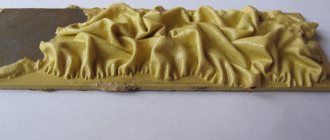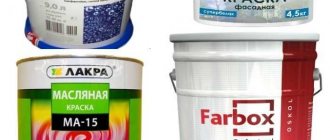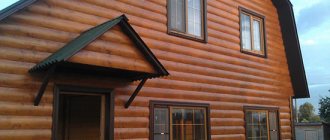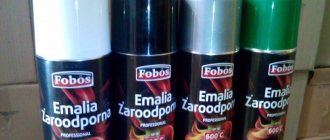The compositions of these materials, which are one of the types of fire protection for metal structures, are needed to prevent sudden heating of the load-bearing frame of buildings and elements of utility networks during the development of a fire, since otherwise metal structures will quickly deform, up to complete collapse.
Treatment of metal structures with fire-resistant paints and varnishes is one of the effective, popular types of passive fire protection, which is also due to the low consumption of materials compared to plasters, pastes, and mastics.
Application
Paint and varnish products for metal structures are used for the purpose of fire-retardant coating of the load-bearing frame - trusses, spans, including complex geometric shapes; beams, columns, supports of both industrial and public buildings, wherever the degree of fire resistance of buildings cannot be ensured without bringing metal structures to the fire resistance limit required by fire safety standards.
Often, protecting metal from fire is necessary for steel structures that not only form a load-bearing frame inside its building volume, but also located outside; depending on design decisions, including the need to enhance seismic resistance.
On this topic ▼
Fire retardant plaster
Types, types for structures and applications for construction projects
In such cases, a weather-resistant fire-retardant paint or varnish is required that can be used outdoors for a long time without cracking, peeling, or shedding due to exposure to moisture, wind, sudden daily temperature changes, as well as at sub-zero temperatures, down to critically low values.
The emergence of fire-resistant paints and varnishes that are resistant to fire, a sharp increase in air temperature in protected premises, fire compartments, sections of buildings for various functional purposes, as well as fire-retardant paints and varnishes that are not exposed to weathering, has made it possible to effectively coat load-bearing steel structures of buildings, engineering, and technological structures in cases where It is impossible or impractical to use fire-retardant plasters, pastes, mastics, as well as structural fire protection from fire-resistant plasterboard with filling the voids with fire-retardant basalt material for various objective reasons.
The advantages of using fire-resistant paints and varnishes on protected objects, compared to traditional coatings, are also:
- Much lower consumption of materials, even with a multi-layer coating, which not only reduces the customer’s costs, but also significantly reduces the load on the load-bearing structures of buildings, including trusses, beams, interfloor ceilings, and foundations. This is often critically necessary when designing large buildings, including sports, cultural and entertainment facilities or buildings with atriums.
- Coating with fire-retardant paints and varnishes does not spoil, but on the contrary, effectively decorates the appearance of the protected metal structures, which is important for architects and designers.
- They not only reliably protect the metal from the effects of flames and high-temperature heat flows, but also from direct contact with moisture, O2 of air, preventing active oxidation, the formation of rust as a result of corrosion, including chemical; which is not uncommon in protected premises with a high category of explosion hazard and aggressive environment.
On this topic ▼
Fire retardant varnishes
Description and application for coatings
Fire-retardant varnishes, like paints, are used to coat load-bearing building structures, transit air ducts in fire hazardous areas and rooms; ducts, shafts of smoke removal systems, air supply; as well as for fire protection of cables and cable lines; as a final protective, decorative layer over other fire-resistant coatings - paints, plasters, mastics, compatible with them.
To summarize, we can conclude: under normal conditions, these are one of the types of high-quality paint and varnish products that have all the advantages of using them both inside and outside buildings.
And if a high-temperature source of fire occurs in them or in fire breaks near them, effective fire-retardant coatings can withstand exposure to fire and high temperatures for the period required by fire safety standards.
Species and types
Manufacturing companies have developed and mass-produced two types of such special paint and varnish products that combine the main functions of protecting metal from external atmospheric influences, from fire and high temperature:
- Intumescent paint is the most common product group of fire-resistant paints and varnishes.
In direct contact with an open flame, a high-temperature heat flow from a fire spreading inside or outside a building, due to their chemical composition, being thermally active materials, they quickly and repeatedly increase in volume tens of times; form a foamed layer of charred coke coating, reminiscent in appearance and internal structure of volcanic pumice.
The composition, in turn, due to its negligible thermal conductivity, effectively prevents the heating of metal structures. This is a reliable fire-retardant coating of the load-bearing frame of buildings, important elements of building life support engineering systems - electrical cable routes, ventilation ducts, including smoke protection systems.
- Non-expanding (volume-preserving) fire-resistant paint or varnish are also multi-layer coatings, but they do not change their original volume even under strong fire or thermal influence.
On this topic ▼
Fire retardant paints
Types, properties, advantages, application rules
Their physicochemical fire protection mechanism differs from intumescent fire-resistant coatings. It is based on silicates, often commonly referred to as liquid glass, which create a dense coating on the surface of metal structures and elements of life support systems of protected objects that reliably protects against external influences under normal conditions.
And under sudden high-temperature exposure, the composition sinteres, forming a coating layer similar to ceramic enamels, which effectively protects the protected metal surface from rapid heating, deformation and destruction.
The disadvantages of such fire-resistant paints and varnishes are greater consumption of materials and lower fire-retardant efficiency than intumescent analogues, so they are used much less frequently on sites.
Temperature ranges
At what temperature is the use of special, heat-resistant primers required? Let's analyze the coating requirements at different operating temperatures.
Up to 60C
In particular, elements of autonomous heating systems fit into this temperature range. Their typical temperature difference between supply and return is 70/50C, which gives no more than +60C on the surface of the heating devices.
At temperatures from 0 to +60 you can safely use general purpose paints and primers. If the painting technology is followed (that is, if the surface is cleaned well and the primer matches the type of paint and varnish material), there is no need to worry about paint delamination or fading.
General purpose paints can be used in an autonomous heating circuit.
Up to 100C
The only significant difference from the previous scenario is the need to use paints with persistent pigments. The binder and primer remain the same as before: all popular types of paint can withstand prolonged heating without destruction.
Practical consequence: cheap and very common GF-021 is a completely suitable primer for radiators both in autonomous heating circuits and in central heating systems.
Up to 300C
And here comes the high point of heat-resistant soils. If the instructions for using temperature-resistant paintwork materials indicate the need for priming, you will have to select special compositions that can withstand prolonged heating and retain their properties over the entire range of operating temperatures.
Over 300C
All paints intended for temperatures above +300 degrees are applied without prior priming, directly onto a cleaned and degreased surface. A layer of soil at such temperatures will only increase the likelihood of the coating peeling off.
Particularly heat-resistant paints are applied directly to the metal base.
A caveat: we are talking about metal surfaces. Strengthening primers for plaster or putty for brick fireplaces and stoves are also used at higher temperatures.
Composition and description
The main technical characteristic of fire-resistant varnishes and paints is their fire-retardant effectiveness, regulated by NPB 236-97, GOST R 53295-2009 for fire protection means for steel structures. According to their definitions and requirements, it varies from group 7 with a fire resistance limit of 15 minutes to group 3 - 90 minutes , and the maximum group 1 - 150 minutes .
On this topic ▼
Table determining the fire resistance limit of building structures
The chemical composition of fire-resistant paints and varnishes is rarely disclosed by manufacturing companies both in advertising brochures and in factory accompanying documentation for supplied commercial products, which, of course, is due to commercial secrets and reluctance to reveal the recipes for creating such innovative materials to competitors.
From public information it is known that they use film-forming substances, reagents that foam under the influence of high temperatures, including thermally active graphite; some types of salts, as well as finely ground mineral fillers.
The following brands of paints and varnishes are the most popular on the Russian market of fire retardants:
- Crouse . Under this brand, NPO Stroyzashchita produces three types of intumescent fire-retardant paints for metal: Krauz, Krauz-Ultra - water-based, creating coatings with a fire-retardant effectiveness of 90 minutes, applied indoors at temperatures above 0 ℃; Krauz-R – on an organic solvent, up to 120 minutes, which can be applied down to – 15 ℃. The service life of coatings is up to 25 years.
- Kron – SW is a fire retardant paint for metal structures with a fire retardant efficiency of 120 min. Application conditions: not lower than – 15 ℃. The guaranteed service life of the coatings is 25 years, with a topcoat – up to 50 years.
- Neomid (Neomid) . This brand produces many types of products for both fire protection of wood and metal structures, including all-season metal paint Neomid 050, intended for work both indoors and outdoors at low temperatures, but without direct exposure to water. Ensuring fire retardant efficiency in the range from 45 to 120 minutes, painting at a temperature not lower than - 25 ℃ with air humidity up to 80%.
- In addition to them, there are fire-resistant paint and varnish products of the brands Pirex - metal plus , Nertex , Thermobarrier , Stabiterm , Negorin .
Effect of refractory composition on metal structures
Certificate of conformity
According to Article 150 of Federal Law-123, to confirm the quality and fire-retardant effectiveness of fire-resistant paint and varnish coatings for any batch of serial products used for painting metal structures of the load-bearing frame of buildings, elements of engineering systems; Regardless of the scope of supply, a fire safety certificate is required, which must indicate the following information:
- Brand, name of fire retardant paint, varnish.
- Fire retardant efficiency group.
- Types, names, quantity, required thickness of layers of primers, finishing protective, decorative coatings compatible with the supplied fireproof products.
- The thickness of layers of fire-retardant paints, varnishes, as well as their costs for obtaining multi-layer coatings for various groups of fire-retardant efficiency.
Requirements
- Paint and varnish products create coatings with the fire-retardant efficiency required for various metal structures.
- The multilayer fire-retardant coatings formed after painting must be durable, not crack, and not be destroyed under external influences, including high air humidity, condensation, and vibration.
- They should not emit vapors of toxic chemical compounds both under normal conditions and during the formation of an intumescent heat-protective layer under fire or thermal influence.
- Meet the requirements of aesthetics in finished form after applying the finishing layer, for which it must be possible to tint them in different colors.
Customers, specialists from design organizations, enterprises carrying out fire protection work on the basis of license permits from the Ministry of Emergency Situations, in accordance with the requirements of fire safety standards, can easily find the best options from the variety of types of fire-resistant paint and varnish products for each specific case of fire protection of metal structures of buildings for various purposes.
Types of primers for metal structures
The primer layer is used for both external and internal work. There are dozens of types of metal primers - they are designed for certain climatic conditions, contain a certain level of toxic substances, and have different compositions and drying times.
The most common primers are:
- Alkyd. The base is alkyd varnishes containing stabilizers and additives. They have double protection - external and internal, and dry quickly.
- Orthophosphoric. Base – acid: used on coatings with rust. Provides metal protection and restores the surface (converts oxides into a non-aggressive product).
- Acrylic water dispersion. Can be used without further opening with a finishing coat of paint (if the paint composition is acidic), or as a quick-drying base for paints and varnishes.
- Epoxy. It is used for structures used in conditions of high humidity (swampy areas, regular heavy rainfall).
Epoxy primers for metal have a high level of protection against moisture and other atmospheric influences. They are used not only for the protection of metal structures, but also for cars.
Application rules
The principle of carrying out work both inside and outside protected objects using such paints and varnishes is painting in several layers, the number of which, depending on the required fire resistance limit of the coating, is determined in the accompanying factory documentation for the product, which also indicates the consumption of fire-retardant paint per 1 m2 for metal .
Fire retardant treatment must alternate between completely drying each layer of fire-resistant paint and varnish.
There are four stages of work when using fire-retardant paints and varnishes to coat metal structures:
- Thorough preparation of the metal surface, including cleaning of layers of previous paint and varnish coatings; dirt – rust, traces of flammable liquids; dust and salt deposits.
- The methods of such preparation are varied - from mechanical processing of metal surfaces with hand or electrified tools, sandblasting machines to chemical cleaning with organic solvents and rust converters.
- It is also extremely important to degrease the surfaces of metal structures to ensure high adhesion when applying the coating.
- Priming with various materials whose physical and chemical properties are compatible with fire-retardant paint and varnish products, which both protects the metal from possible corrosion and promotes more reliable contact of paints and varnishes with the surface of metal structures, without the risk of cracking and peeling.
- Painting metal structures manually using brushes, rollers, or using industrial equipment for painting work - spray guns, airless spray stations.
- Application of protective, finishing decorative coatings, both protecting fire-retardant paints and varnishes from external influences, including atmospheric influences, and giving them a pleasant appearance, which is achieved, among other things, by tinting.
Quite often, varnish from the same manufacturer is used as a finishing coating for fire-resistant paint, which guarantees their maximum compatibility and durability of the resulting combined fire-retardant coating.
Goals
First, let's state the goals of applying a base coat.
Why prime surfaces that heat up during use?
- To improve the adhesion of the base coat.
Helpful: Many primers not only have excellent adhesion on their own; they also transform the surface on which they are applied. Thus, a primer for heating pipes containing a rust converter chemically transforms the oxide film into a durable insoluble coating, which becomes the basis for the enamel.
- For protection against corrosion . Anti-corrosion primers can be used not only as a base layer, but also as an independent coating.
- To compensate for the difference in the coefficient of thermal expansion of the paint coating and the base.
- To reduce the absorbent properties of the surface and, accordingly, reduce paint consumption . This property is relevant for brick stoves and fireplaces; the price of primers is noticeably lower than the cost of paint of comparable quality, so economically, priming is more than justified.











